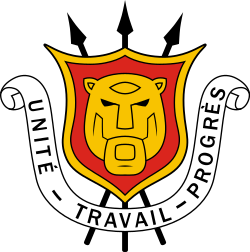| Coat of arms of Burundi | |
|---|---|
 | |
| Armiger | Republic of Burundi |
| Adopted | 1966 |
| Motto | Unité, Travail, Progrès ('Unity, Labour, Progress') |
The coat of arms of Burundi, adopted in 1966, consists of a shield surrounded by three spears. On the shield is the motto of the nation, as well as the head of a lion. Behind the shield there are three crossed traditional African spears. Under the shield the national motto of Burundi appears on a scroll: Unité, Travail, Progrès (French for 'Unity, Labour, Progress'). [1]



